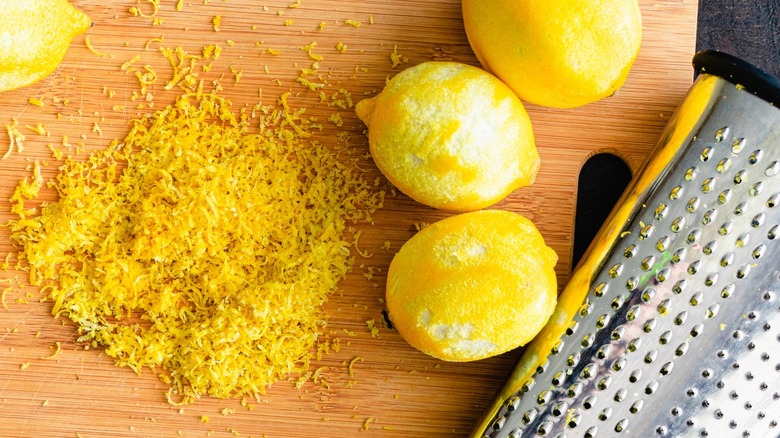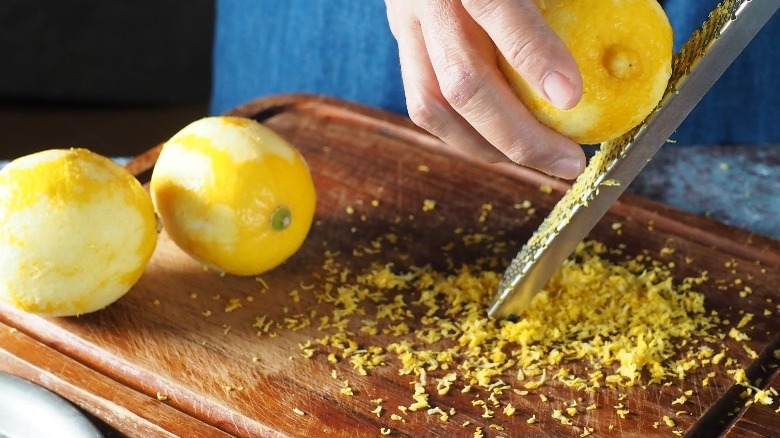The Best Zesting Tool For Your Desired Texture
Whether you are baking up a batch of lemon bars for Sunday brunch or want to take steak night to a new level with a citrusy pesto, zest is a surefire way to give your culinary artistry a bright and peppy boost.
But what exactly is zest? The term refers to the skin of citrus fruits such as lemons, limes, oranges, and grapefruits. It's also the most flavorful part of these brightly tart-sweet fruits. In fact, it's where all those luscious essential oils live, giving citrus peel its concentrated zeal and injecting a little sunshine into your dish without all the acidity that juice brings. And while fresh zest is best, you can also dry zest strips, grinding them up to create a zippy citrus powder and candy peels for use in desserts or preserve leftover shavings by freezing them for up to three months. And this versatile little ingredient packs a punch, waking up the flavor in just about anything from salad dressings to popcorn to cookies.
The process of zesting itself is the scraping or cutting off of the colorful part of the peel (the flavedo) away from the inner layer of the peel (the albedo) — the bitter, white pith. While this can be achieved in several ways, you'll be best served to know which tool to pair with the desired texture you wish to amplify in your dish. Just scrub your citrus under running water first to decrease the likelihood of foodborne illness.
The rasp and zester
A rasp is a long slender handheld grater. If you think you'll do a lot of zesting, you may want to invest in a Microplane rasp. A coveted tool of the trade, a Microplane consistently produces finely grated zest perfect for dressings, sauces, marinades, and doughs for baked goods — basically, any recipe where you want the flavor of zest sans heavy peel texture. If this tool is new to you, read a tutorial first, as it is often misused. (Quick tip — turn the fruit after every pass along the Microplane, so you don't wind up with the pith in your mix.)
If you don't have access to a Microplane, a box grater can be a great substitute. Make sure you use the side with the small star-shaped holes and not the side with the larger holes intended for grating cheeses like cheddar or Monterey jack.
On the other hand, if you'd like to add a bit of fun and whimsy to your zesting festivities, a true zester or channel knife might be a perfect fit, allowing you to zest in long, curly strips. This handheld tool looks like a fork with three to four holes at the top rather than tines. This coarse-textured zest is perfect as a garnish and for topping salads or cakes. It can also be used in sauces to add a little more texture.
Peeler and paring knife
Love the texture of a wide strip or long curl of zest in your cocktail instead of those sticky-fine shavings? A standard vegetable peeler can be your very zest, I mean best, friend. These zippy strips are perfect for infusing flavors as the citrus oils release easily — especially if you give it a twist — into oil, syrup, and cocktails. They're even a perfect pep-up when used in the braising of meats.
And finally, if you're feeling zesty and there's nothing else around, you could always use a paring knife. First, cut one end of the fruit off so you can stand it upright. (This prevents it from rolling around.) Then, just peel off the outer layer like you would an apple, going slow so you get as little of the pith as possible. Once you've slivered off enough slices, place them on a cutting board, zest side down, and use the knife to get rid of any excess pith. This is great for garnish — alternatively, you can chop up the strips for other applications.
Word of advice: if the recipe calls for citrus juice in addition to the zest, always zest first.


